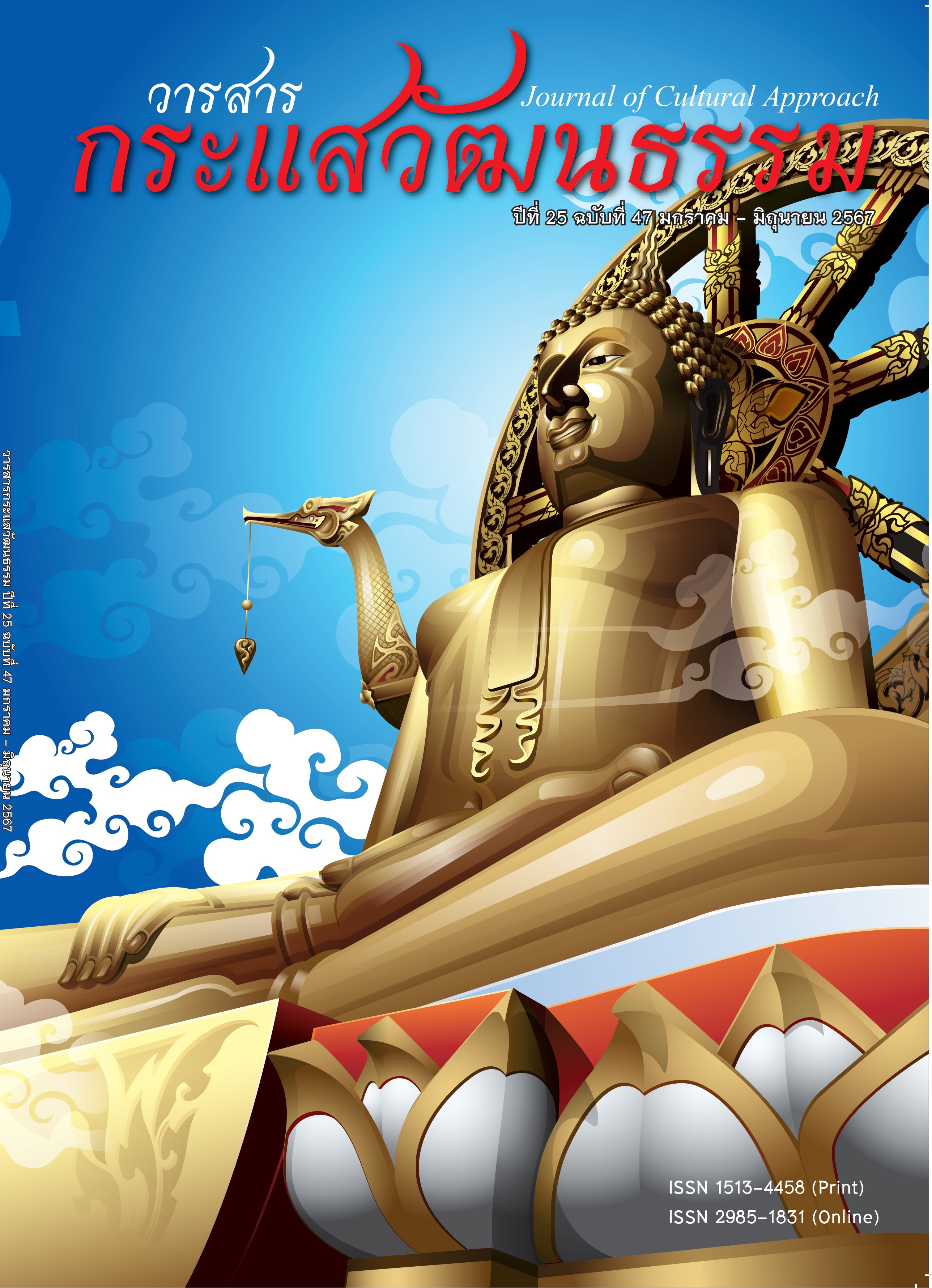นาฏยประดิษฐ์: ชุดจุฬาเมาลี
Main Article Content
บทคัดย่อ
บทความวิจัยนาฏยประดิษฐ์ ชุดจุฬาเมาลี มีวัตถุประสงค์เพื่อสร้างสรรค์และออกแบบการแสดงนาฏศิลป์ ซึ่งนำเสนอในรูปแบบของงานวิจัยเชิงสร้างสรรค์ โดยมีแนวคิดและทฤษฎีนาฏยประดิษฐ์ร่วมกับการปฏิบัติการเพื่อนำข้อมูลทั้งหมดมาวิเคราะห์และนำมาสร้างสรรค์ผลงานการแสดงนาฏศิลป์ตามลำดับ
ผลการวิจัยพบว่า นาฏยประดิษฐ์ชุดจุฬาเมาลี ประกอบไปด้วย 7 องค์ประกอบ ได้แก่ 1) แนวความคิด 2) นักแสดง 3) การประพันธ์บทร้องบรรจุเพลง 4) การออกแบบท่ารำ 5) การออกแบบเครื่องประดับและเครื่องแต่งกาย 6) การกำหนดใช้พื้นที่บนเวทีการแสดง 7) อุปกรณ์ประกอบการแสดงและการจัดวางบนเวที หากพิจารณานาฏยประดิษฐ์ชุดจุฬาเมาลีอย่างซาบซึ้งมากกว่าสุนทรียภาพของความงามในเชิงศิลปะ การรับรู้ความหมายและการกระทำอันยิ่งใหญ่ของเจ้าชายสิทธัตถะ อาจทำให้เกิดแรงบันดาลใจ และเป็นการเรียนรู้ธรรมะผ่านสื่อในรูปแบบอื่นที่แตกต่างออกไปจากการเข้าวัดทำบุญ การแสดงชุดนี้เป็นการแสดงชุดหนึ่งที่เป็นประโยชน์ทางการศึกษาและทางการแสดง ผลการประเมินจากผู้ทรงคุณวุฒิพบว่านาฏยประดิษฐ์ชุดจุฬาเมาลีได้คะแนนร้อยละ 84
Article Details

อนุญาตภายใต้เงื่อนไข Creative Commons Attribution-NonCommercial-NoDerivatives 4.0 International License.
Proposed Creative Commons Copyright Notices
1. Proposed Policy for Journals That Offer Open Access
Authors who publish with this journal agree to the following terms:
- Authors retain copyright and grant the journal right of first publication with the work simultaneously licensed under a Creative Commons Attribution License that allows others to share the work with an acknowledgement of the work's authorship and initial publication in this journal.
- Authors are able to enter into separate, additional contractual arrangements for the non-exclusive distribution of the journal's published version of the work (e.g., post it to an institutional repository or publish it in a book), with an acknowledgement of its initial publication in this journal.
- Authors are permitted and encouraged to post their work online (e.g., in institutional repositories or on their website) prior to and during the submission process, as it can lead to productive exchanges, as well as earlier and greater citation of published work (See The Effect of Open Access).
Proposed Policy for Journals That Offer Delayed Open Access
Authors who publish with this journal agree to the following terms:
- Authors retain copyright and grant the journal right of first publication, with the work [SPECIFY PERIOD OF TIME] after publication simultaneously licensed under a Creative Commons Attribution License that allows others to share the work with an acknowledgement of the work's authorship and initial publication in this journal.
- Authors are able to enter into separate, additional contractual arrangements for the non-exclusive distribution of the journal's published version of the work (e.g., post it to an institutional repository or publish it in a book), with an acknowledgement of its initial publication in this journal.
- Authors are permitted and encouraged to post their work online (e.g., in institutional repositories or on their website) prior to and during the submission process, as it can lead to productive exchanges, as well as earlier and greater citation of published work (See The Effect of Open Access).
เอกสารอ้างอิง
Atayaphan, S. & Chansuwan, P. (2019). Choreographic Invention Naga Principle Sattha Naga. Chophayom Journal, 30(2), 185–194.
Bhalakula, A. (2020). Buddha – the Enlightened Person Who Had Left Suffering State: A Comparative Analysis on Contemporary Study in Politics and Governing During the Buddha Era and the Refusal of Power to Govern the State of Crown Prince Siddhartha. Journal of MCU Phetchaburi Review, 3(2), 31–45.
Daengpradup, S. (2021). Bliss. Silpakorn University.
Dhamma Perfect. (2007). Tripitaka. https://84000.org/tipitaka/attha/attha.php?b=32&i=1&p=7
Khamnong, T. (2020). Biography of Lord Buddha in the Time of the Ordination: Hermeneutic Based on Nettippakarana Canon. Journal of MCU Buddhist Review, 4(2), 16–33.
Khongthaworn, K. (2019). Traditional Dancers Bathing the Suhara Nakong Tone: Royal Dance Traditions. Research and Development Journal, Suan Sunandha Rajabhat University, 7(3), 32–42.
Phetruchee, M. (2021). The Choreography: Lady Madri Songkrueng. Udon Thani Rajabhat University Journal of Humanities and Social Science, 10(2), 1–16.
Somboonsuk, W. & Phothiwachakul, S. (2018). The Creative Procedure is about the Choreography of Nakhon Ratchasima Dramatic Arts College. Ratchapruek Journal, 6(2), 61–68.
Suriyasangpetch, W. (2019). An Analytical Study of the Reasons for Renunciation of Prince Siddhartha. Journal of MCU Humanities Review, 4(2), 273–284.
Thongpan, S. (2020). Chula Mani. https://www.sarakadee.com/2020/02/19/chula-mani/


